Guest Post by Aivaras Jefanovas.
This fieldwork diary entry is a continuation of my previous article on the ethnographic investigation I am conducting into human-animal relationships in Siberia. I have just finished the second phase of my participant observation among Eveny reindeer herders in North Yakutia, Russia.
While my PhD thesis mostly focuses on interactions between people and predator animals, for this article I decided to write about the life of an Eveny reindeer herdsman named Afonia. Afonia is a modern and skillful leader as well as a successful family man who engages in traditional reindeer herding in the Siberian Taiga.
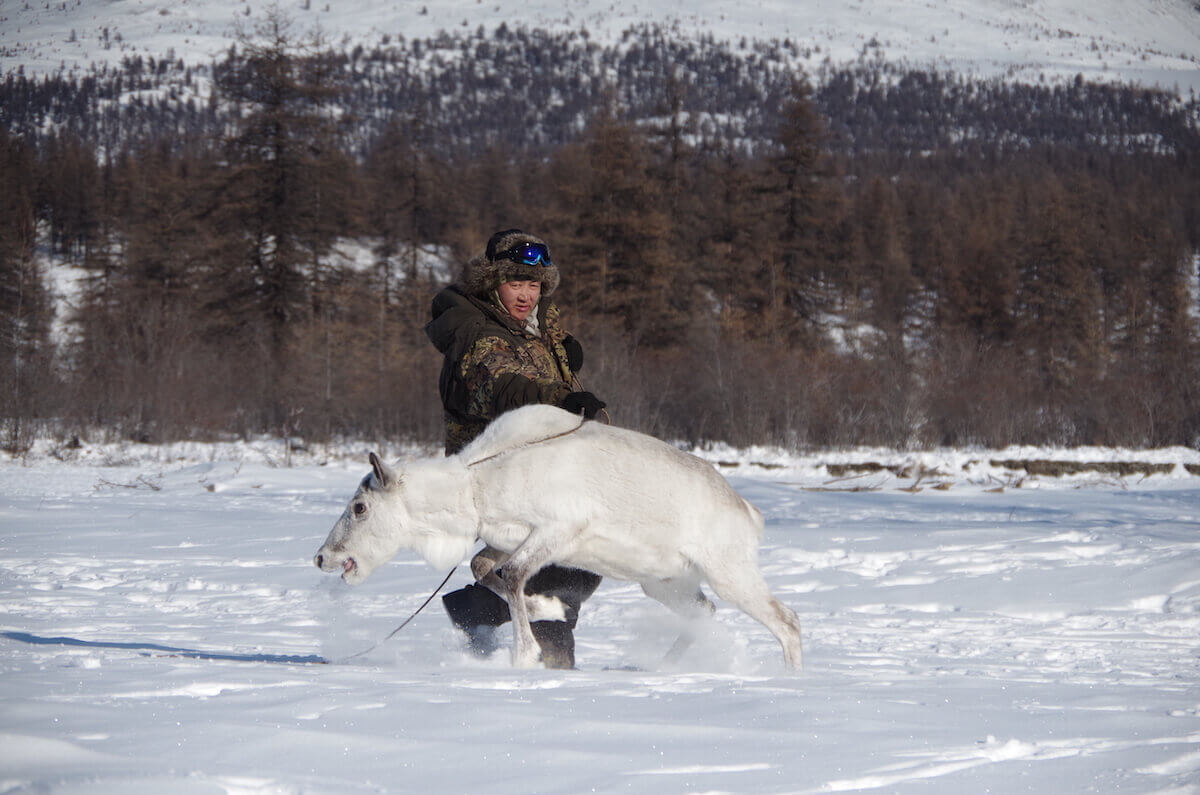
Afonia’s daily duties in the Taiga involve finding and bringing the reindeer back to camp
The decision to take this narrative approach was driven by the idea that I wanted to observe daily subsistence strategies from an indigenous perspective, leading to an in-depth understanding of Eveny society. Moreover, my interest in this topic was sparked by my previous work using MAXQDA, and I wanted to see what tools were available for the description of a single individual’s character and habits, as well as how that would correspond to the whole community. The characterization of personalities is commonly used to describe a social background of an anthropological study (see R.M. Ericson, Writing Ethnographic Fieldnotes, 1995).
The biggest challenge I faced after I returned from the field with a huge amount of handwritten texts, pictures, and many hours of recordings, was the question of how I would retype and transcribe all of this data. Soon, I realized that it would take far too much time. Fortunately, MAXQDA was a great help here because I simply scanned my field notes and used MAXQDA’s Transcription Mode to quickly transcribe my recordings and then code, write memos, and retrieve all of the information I needed for Afonia’s life description. Thus, by applying MAXQDA in a descriptive manner, I discovered that the software is the perfect aid for this kind of qualitative research, as it enabled me to import all kinds of data (e.g. field notes, pictures, audio recordings, interviews, memos, scanned text, etc.) in one place, and to organize and analyze it.
Generating the ideas for the narrative by creatively organizing my categories
First, using MAXQDA’s Creative Coding function, I visualized my purposive raw code system, which contains a lot of brainstormed categories. Of course, for a consistent retelling of my experience, I had to plan how different kinds of ideas would connect to each other and could be visually laid out.
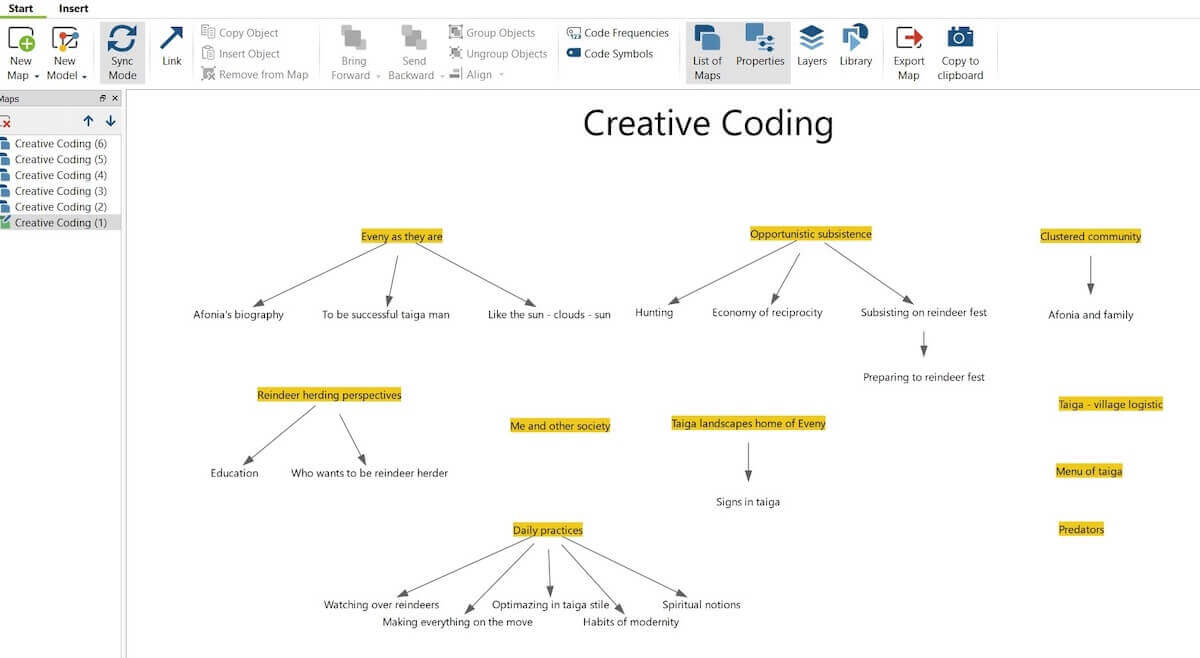
My initial ideas laid out using MAXQDA’s Creative Coding function for further adjustments
Next, I used MAXQDA’s Code Relations Browser, which allowed me to consider how many codes overlapped. The little squares (see the screenshot below) visually represent the number of co-occurrences of codes. I also examined which two codes are present at a defined distance from one another with the Near (codes) function.
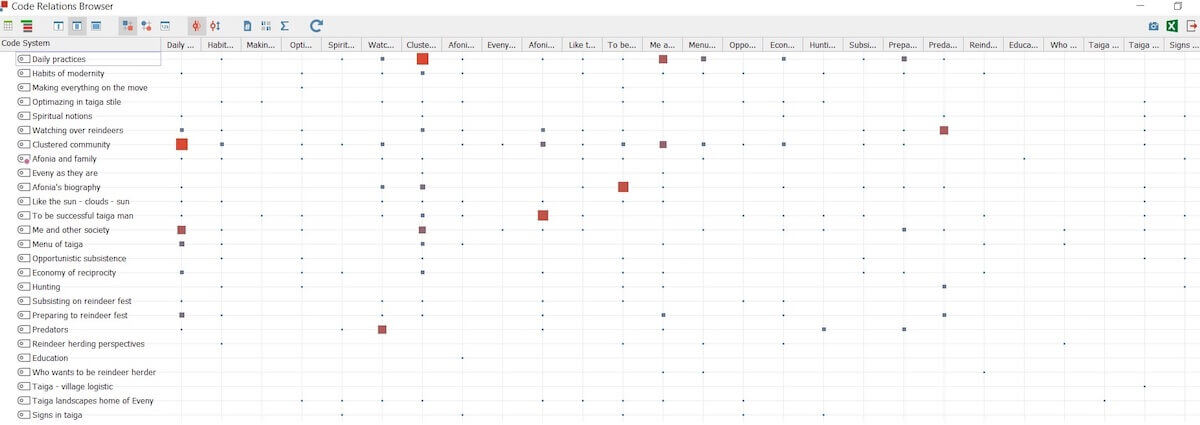
Visualization of overlapping codes using MAXQDA’s Code Relations Browser, allowing me to reconsider my ideas in greater detail
A review of the overlapping codes helped me to analyze which ideas occurred repeatedly in my coded segments. MAXQDA’s visual tools offered further useful options to optimize my code system.
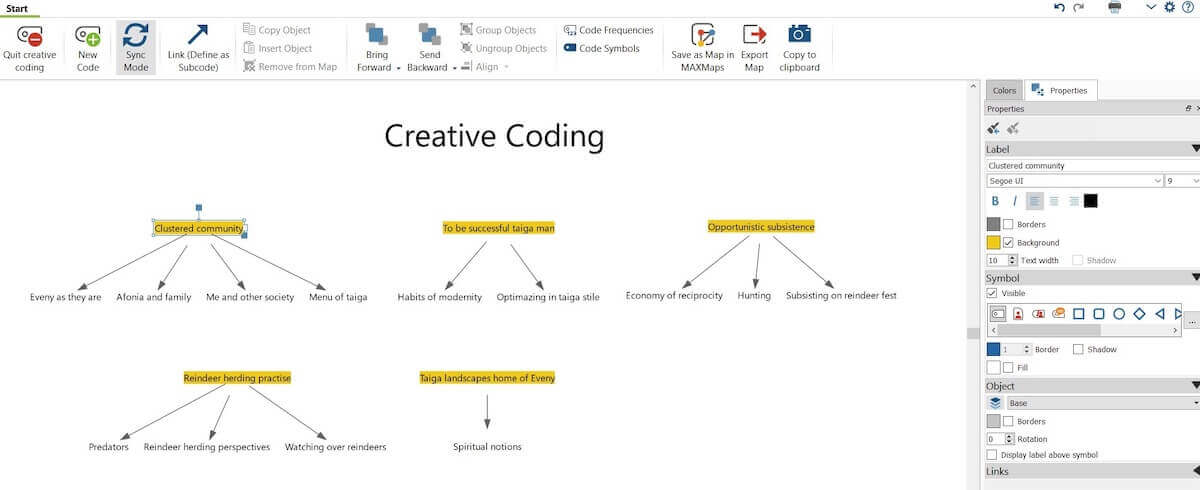
Creative coding improved my code system by allowing me to congregate related themes and generate new ones
Finally, I also have to mention that MAXQDA offers great options for importing and coding scanned documents. This feature saved me time, as I could import my own handwritten field notes, escaping the tedium of endless retyping. Moreover, while I was coding my scanned field notes, I could also write the memos at the same time, which I then exported and recoded as a separate document.
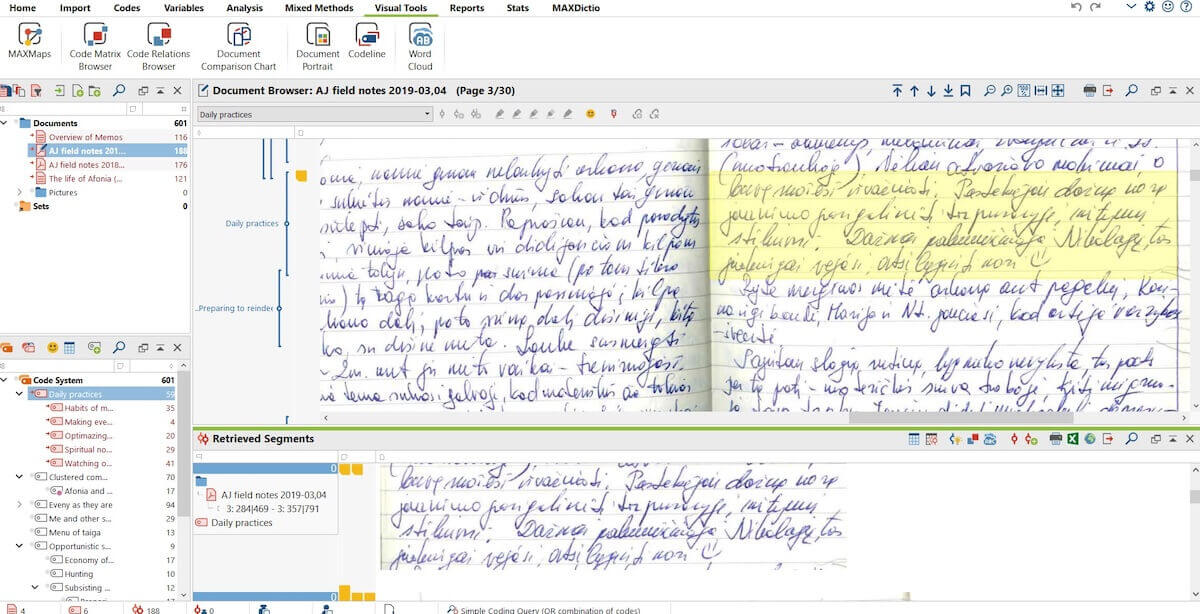
Importing and coding scanned field notes, which saved time and effectively improved further analysis
Based on my field data narrative analysis with MAXQDA, I will now describe Siberian indigenous life, which is honest and simple on the one hand, and full of subtleties, mysteries, and unexpected discoveries on the other.
Meet Afonia, a successful Taiga man
A small Russian plane was swaying in the cold Arctic wind while preparing to land in the mountainous landscape of the Eveny homeland. I had flown 800km from the Yakutsk city to the local airport of the northern Siberian village of Sakkyryr. I remember that before my departure, people from Yakutsk were asking why I was so driven to go to such a remote place. Even though it was already the beginning of March, temperatures still frequently dropped to -30 C during the day and -40 C at night. Knowing this and that Taiga would be covered with snow until the middle of May, I took two heavy backpacks with Arctic equipment and warm clothes with me from my home in Lithuania. The baggage was so full that I could hardly move while I was looking for my transportation after landing.
Suddenly, I recognized an approaching Russian “UAZ” van that belonged to Afanasii Konstantinov, locally called Afonia, who was a person that I had gotten to know during my visit the year before. Afonia took my baggage and vigorously threw it into the truck. His mother Maria was already inside, together with Afonia’s wife Varvara (Varia), his fourteen-year-old daughter Maia, twelve-year-old Martin and seven-year-old Karina, and the youngest, his three-year-old son Aigyl. Afonia said that he and his family were at the airport to pick up his mother, who was coming back from the city in the same plane as me, as well as to bring me back to his reindeer encampment in the Taiga, where I had lived and researched the year before.
I was surprised at how this meeting had happened so spontaneously. I hadn’t pre-organized it at all but Afonia was aware of my arrival based on the last call I had made almost a month before. At that moment I thought about how reliability and thinking ahead can be considered the most valued attributes for a Taiga man. In certain circumstances, arriving on time can be a matter of life or death in the unpredictable Arctic environment. Local people from the town Sakkyryr described Afonia as the most reliable person they knew, even comparing him with Mother Theresa because he has taken care of so many.
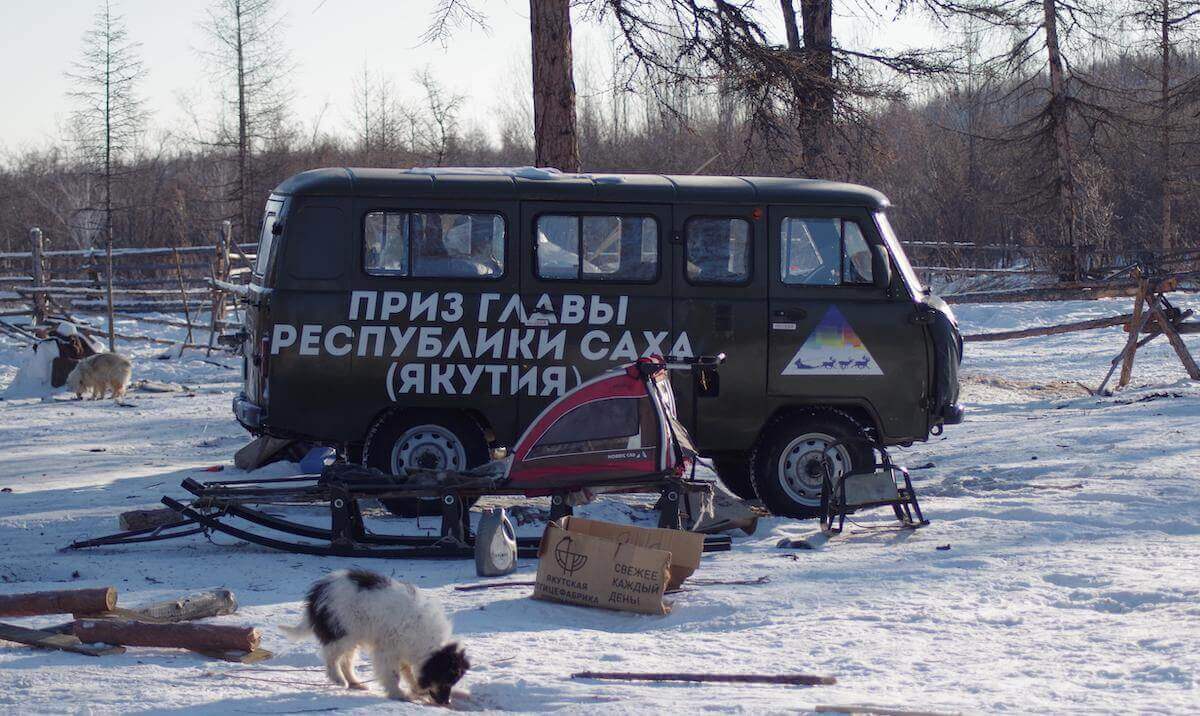
Afonia’s van with which he picked me up from the airport
Afonia is a 38-year-old indigenous man who comes from a prominent family of reindeer herders that were well recognized during Soviet times as either prosperous brigadiers of several reindeer herds or as skillful hunters. His father was a pure Yakut man with a keen intelligence who succeeded in school, but instead of continuing his education post-school he had to work hard on the farm, starting at an early age to help care for his younger brothers and sisters. Afonia’s mother has Eveny roots but her father was a Yakut man too. Although Afonia links himself more to his Even than Yakut roots, he prefers to call himself a local Taiga man.
Throughout his life, Afonia has perfected the skills of a Taiga craftsman, hunter and herder – skills he learned from his father. As a child, Afonia attended Sakkyryr Primary School and then went to another town near the city of Yakutsk to attend high school. Afonia told me that even though he pursued further education in Yakutsk as a professional driver and a welder, the Taiga called him back every time and he soon gave it up to return to his hometown.
He then married an Eveny woman and immediately turned to Taiga life, taking the position of reindeer herd brigadier, where he continues to work today and successfully apply his mastery of skills. Everyone in the Taiga and the surrounding town knows that if you need a blacksmith, a welder of broken tools, a mechanic for engines, or anything else of that nature, you can rely on Afonia. Afonia is also the main person in village you would contact if you wanted to visit the remote reindeer encampment in the Taiga, especially in winter, when it becomes easiest to reach it via the frozen rivers of “Big Sakkyryr” and “Tumara” using Afonia’s van or snowmobile. Interestingly, the year before, I had met a traveling Norwegian family that came to Afonia’s camp to experience Siberian reindeer herder life.
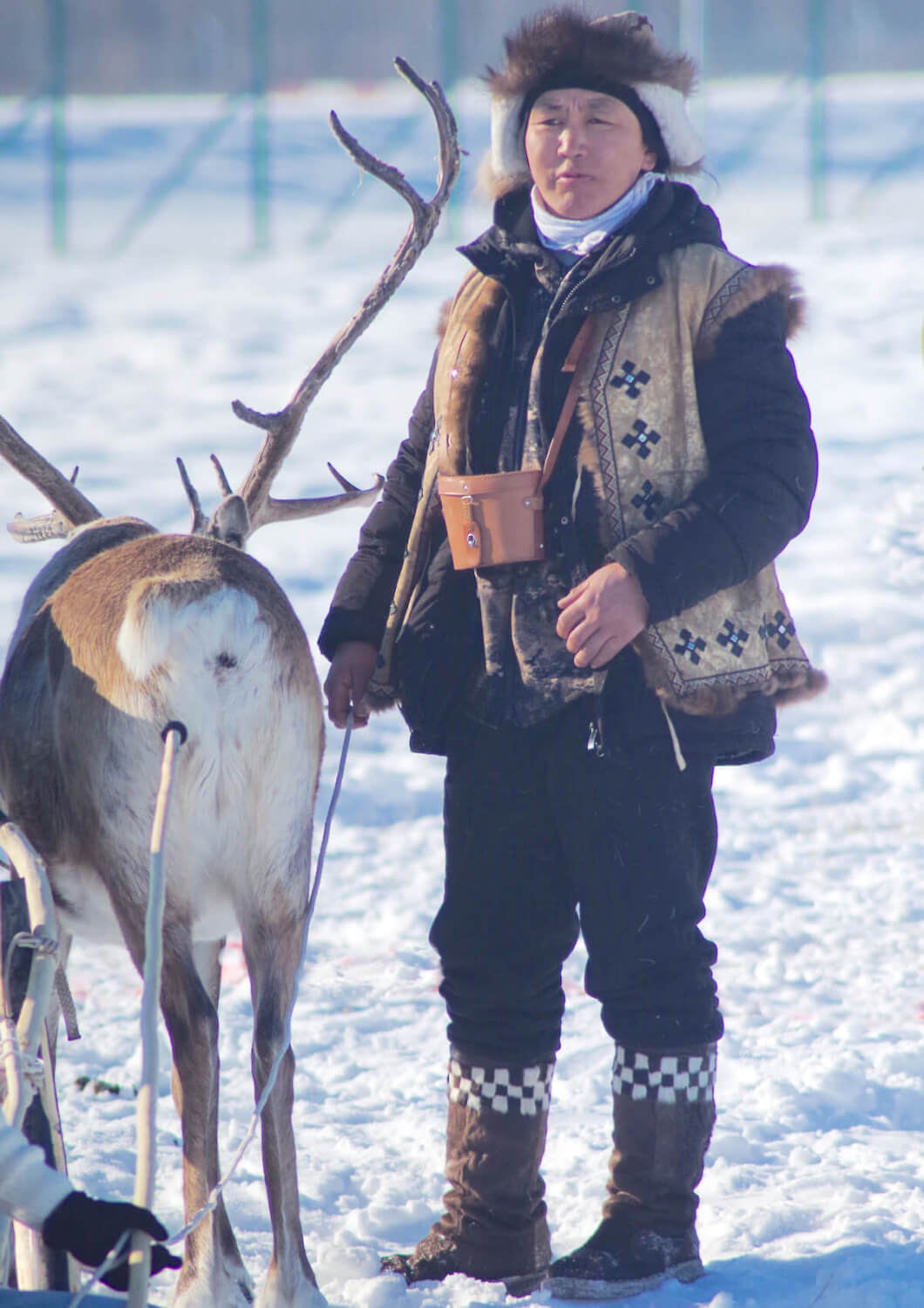
Afonia wearing a traditional Eveny competition suit during a reindeer festival
From my experience, it seems that Afonia was brought up to be a careful and courageous person, who is well admired in his community. From the first time I met Afonia, I was impressed by his highly energetic disposition and, at the same time, his calm, self-confident manner. I remember that he came across as very relaxed, wearing American sunglasses and calmly smoking cigarettes while driving snowmobiles many kilometers through mountain ridges, expertly maneuvering between the trees in the thick Taiga forests at high speed.
Once, I called him a man gifted by the power of a hundred reindeer. During the collective reindeer recounting and marking work, I participated in with him and other herders, he was catching and taking down animals one after another nonstop for three whole days. After the job was done and almost two thousand reindeer were counted, Afonia took his snowmobile and went right on to the next herd many kilometers away. I asked with surprise if he didn’t feel exhausted after such hard work, as I was so tired that I couldn’t even raise my hands. He answered that no matter how you feel, you have to do what you have to do because who else is going to do it? This exchange gave me a deeper understanding of the principles of perseverance and opportunistic subsistence that form the foundation of the Eveny reindeer herder’s way of life in the Taiga. No matter what happens – blizzard, flood, extreme cold, rains, or Taiga fires – the herders will see to it that the job gets done.
Afonia is thus known as a strong and tireless leader in his community as well as a master sportsman in Arctic multi-faceted competitions, including reindeer riding, reindeer sled races, lasso throwing, wrestling, sport shooting, skiing, running, and more. He is the winner of many of such competitions held by the Sakha Republic, the Russian Federation, and at the international level. I have seen countless cups, medals, and prizes displayed in his village house. Once, I asked him to tell me about them, but he has won so many times that he couldn’t even remember where each of the prizes came from. That said, his participation in these competitions is an important part of his life because his sports winning strongly supplement his family’s income, as first-place prizes come with a high monetary value.
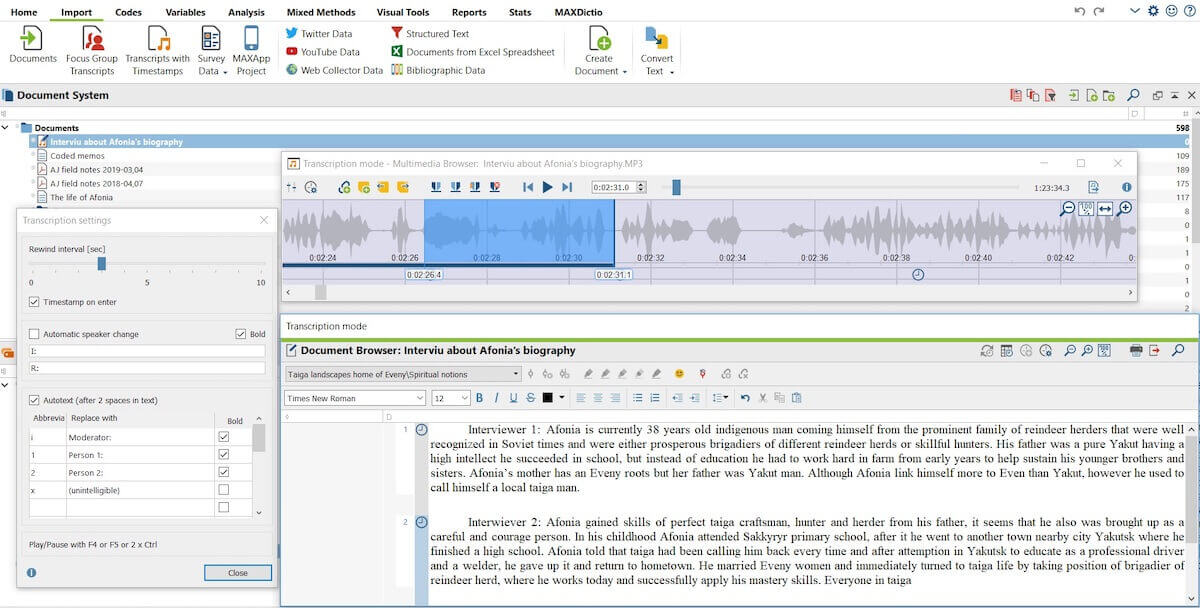
It was really helpful to use MAXQDA’s Transcription Mode for transcribing interviews with local people who talked about Afonia’s life history
Being such a strong and successful man, Afonia is able to provide and care for his family. I noticed that his family members, especially the kids, are equipped with the latest technology such as smartphones, tablets, laptops, digital action cameras, etc. I remember how astonishing it was for me to watch Afonia raise his drone to fly and look for scattered reindeer. Moreover, to my surprise, the family had mobile satellite equipment for internet access and could communicate via social networks with other family members, friends in surrounding villages and cities from right there, deep in the Taiga.
Who would have thought 10 years ago that modernity would reach the most remote corners of our planet, where Eveny locals were, until recently, mostly dependent on their reindeer? These observations changed my previous notions and preconceptions about reindeer herder life in the Taiga. Before I met Afonia, I had little idea about how quickly after the collapse of the Soviet state this community would be able to adapt to the modern world and its new global market economy.
Continued in Part 2
Spend a day with a nomadic family and learn more about Afonia in the second part of this article, coming out next week right here in the MAXQDA Research Blog! Aivaras Jefanovas takes us into the river valleys to spend the cold period with Afonia and his family at their log cabins. Learn more about the Eveny subsistence lifestyle in the Taiga and see what a traditional reindeer festival is like – as well as how Aivaras used MAXQDA to analyze valuable image data from the field!
In the meantime, be sure to check out Aivara’s first Fieldwork Diary Entry to get an overview of his project and learn more about the first stages of his research in the Siberian Taiga and analysis work with MAXQDA 2018:
Aivaras’s first
Fieldwork Diary Entry
About the Author
Aivaras Jefanovas is a recipient of the 2018 #ResearchforChange Grant. He is a PhD student in Ethnology at Vilnius University Institute of Asian And Transcultural Studies. His research project titled “Investigation of sociocultural relationships between humans and animals among Siberian reindeer herders and hunters” began in March 2018.

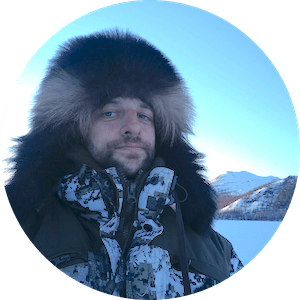 Aivaras Jefanovas is a recipient of the 2018 #ResearchforChange Grant. He is a PhD student in Ethnology at Vilnius University Institute of Asian And Transcultural Studies. His research project titled “Investigation of sociocultural relationships between humans and animals among Siberian reindeer herders and hunters” began in March 2018.
Aivaras Jefanovas is a recipient of the 2018 #ResearchforChange Grant. He is a PhD student in Ethnology at Vilnius University Institute of Asian And Transcultural Studies. His research project titled “Investigation of sociocultural relationships between humans and animals among Siberian reindeer herders and hunters” began in March 2018.


